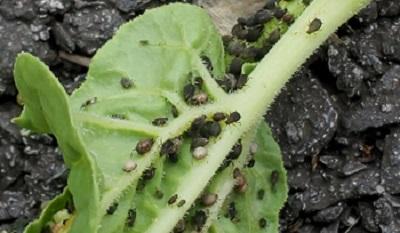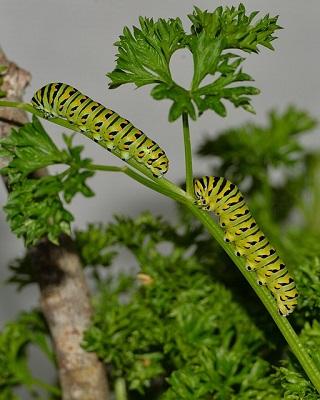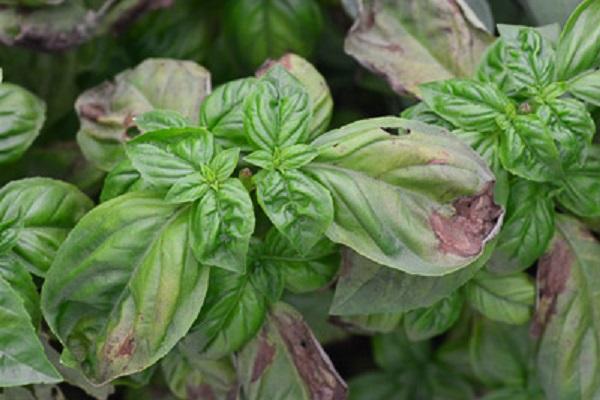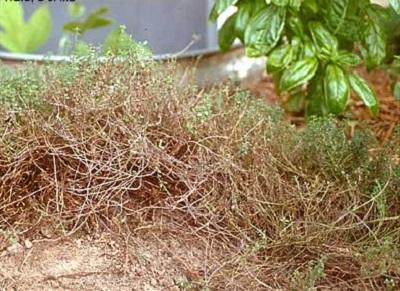Common diseases and insect pests of herbs

This article was posted by the University of Maryland Extension
Aphids

Aphids have a wide range of host plants. They can be found on plant stems and on leaves. Look for beneficial insects like lady bugs that feed on aphids helping to keep them under control
Caterpillars (Black swallowtail or parsley worm caterpillar)
Parsley, dill, and fennel are some of the host plants of the black swallowtail caterpillar. They can have voracious appetites. But because these caterpillars turn into black swallowtail butterflies, a native butterfly to most of the eastern United States and beyond, the damage should be tolerated. One solution is to plant extra so there will be enough herbs for you and for the caterpillars.

Four-lined plant bugs
The four-lined plant bug is a pest in the garden in May and June (one generation per year). The adults are 3/16 of an inch long and yellowish green with 4 black stripes down the back. The nymphs (immature bugs) are red with yellow and black wing pads partially covering the body. This bug feeds on over 250 herbaceous plants. Damage from this plant bug begins as yellow stipples or spots, eventually becoming brown to black necrotic spots. In large infestations, these spots coalesce and cause leaves to turn brown. Four-lined plant bugs are quick and difficult to detect, and only a few can cause noticeable damage. Spraying an insecticide is not recommended. Lightly prune damaged plants to encourage new growth.
Japanese beetles
Japanese beetles can be a problem eating basil. Handpick adults or tap infested leaves over a container of soapy water – the beetles will fall in and drown. Avoid baited traps: they attract extra beetles that will increase damage. Do not spray insecticides on herbs.
Spider mites
Spider mites are tiny, eight-legged non-insects (related to spiders) about the size of a punctuation period. You notice the damage first. Spider mites' puncture-and-suck mode of feeding produces yellow or white stippling and leads to reddish or pale discoloration of leaves. Overall plants look unhealthy.
Diseases of herbs
Downy mildew of basil

Leaf yellowing is the most noticeable symptom on basil infected with basil downy mildew.
Southern blight

Southern blight is caused by the fungus Sclerotium rolfsii. This fungus can attack many herbaceous perennials including herbs. It is active only during hot weather.
Problems caused by abiotic (nonliving) factors
Bolting
Bolting is defined as flowering and going to seed prematurely, usually due to unsuitable climatic conditions at certain stages of growth. Cilantro is very prone to bolting in response to high temperatures.
Basil also begins to flower soon after planting. Pinch off the flowers as soon as they appear to prolong production and keep harvesting the leaves.
Overwatering
Poorly drained soil, water that pools due to the slope or plants being overwatered can cause irreversible damage to herbs. Excess water reduces oxygen in the soil, which damages fine roots and renders the plant unable to take up water. Overwatered plants show the same symptoms as plants with root rots, crown rots (crown rot from overwatering), or drought stress. The primary symptom of excess moisture is wilting or yellowing of lower and inner leaves. If excess water continues, plants may experience symptoms such as scorch, leaf drop, and/ or plant death.
Plants should be watered when needed. Factors influencing plant watering include the stage of growth, time of year, humidity, and temperature.
Winter injury
Excessively wet, cold soil can cause Mediterranean herbs such as rosemary, thyme, and lavenders to die over the winter. Find more information on overwintering herbs on our herb care page.








































